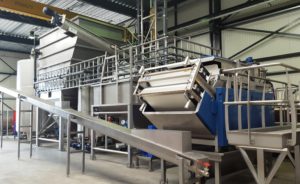Early-stage processing water purification can help reduce usage, costs
The Centers for Disease Control and Prevention (CDC) reports one in six Americans gets sick from eating contaminated food each year. Pressure on producers, processors and food retailers to reduce foodborne illnesses and outbreaks has increased as a result.
While processors often look to end-of-line solutions to improve wash water hygiene, according to Dutch company VAM WaterTech many of today’s water hygiene challenges can be addressed at the pre-wash stage. The benefits include enhanced food safety, longer shelf life and significantly reduced water usage. Company director Hans Blaak explained.
Food contamination can occur anywhere in the supply chain — particularly in washing, packing and processing plants. Washing produce with water removes most harmful bacteria such as salmonella, listeria and E. coli, as well as pesticide residues, and fungi and mold spores. But contaminants left on the surface of produce can continue to multiply if not properly removed from the produce or the washing water. Contamination can and will spread in fruits and vegetables that are washed in unclean water, leading to massive waste due to recalls.
Hygiene isn’t the only stressor when it comes to wash water. Concerns about water scarcity have also put pressure on processors to reduce or reuse wash water wherever possible. In Europe, unless processors can prove that water quality will not impact food safety, legislation states that recycled water must be of the same standard as drinking water.
At the international level, the FAO stipulates that re-circulated water intended for reuse should be treated and maintained in a way that it poses no risk to food safety. According to Blaak, these demands make the recycling and reuse of processing water particularly challenging, but not impossible. But replacing process water with drinkable water every time a new batch of fruits or vegetables needs to be washed is not only costly, it’s inefficient and environmentally unsound, he said.
VAM WaterTech develops custom-made water purification solutions for processors, treating water in the first phase of the washing process. The company works primarily with fresh produce processors and packers in the potato, vegetable and hard fruit sectors, providing solutions for the treatment and reuse of washing water.
Most processors look to end-of-line solutions when purifying water, said Blaak. Rather than replenishing water at each stage in the processing line, wash water is continuously cleaned and refreshed using a water purification installation.
“We only treat the water of the first washing when it’s coming from the field, for example, potatoes containing sand, silt, leaves and stones,” explained Blaak.
Installations include technology for filtration, sand and soil removal, sludge dewatering and disinfection.
How it works
In the first stage, visible, rough particles are separated out using a curved screen or rotating drum filter. At this stage, all material 2 millimeters in size or higher is filtered out.
After that, fine sand 63 microns and higher is removed, and then water is removed from the filtered sand until it’s 70-80 dry solids, making it easy to handle and transport.
Following this, silt and fine sand less than 63 microns in size is removed via sedimentation using a flocculant or clarifying agent. This is a critical step in the process, said Blaak. Silt and dirt is measured to determine how much flocculant is needed. Sedimentation is continuously optimized and adjusted automatically. After this step, treated water is transparent and visibly clear again; 80-90% of bacteria, spores, fungi and pesticides are removed.
The settled sediment is further treated to remove as much water as possible.
The sludge is pressed until it is a dry cake of clay. Most processors return the soil to the field where the crop was grown.

After this step, water is re-used in the washing process. Only 3-4% of the total volume is lost during the cycle. This amounts to a huge savings in water. Processors that use settling ponds need five to six times more water to refresh their system, said Blaak. Depending on the needs of the process, VAM WaterTech offers more treatments that disinfect water even further, if necessary.
After flocculation the water is further filtered to take out clay particles that have not sedimented. Using advanced oxidation process (AOP) technology, the water is further disinfected. AOP is a combination of ozone reaction in the water and UV that destroys everything it encounters, namely chemicals and pesticides, pesticides and bacteria. AOP can only be used if the water is already clean, otherwise the process won’t work, said Blaak.
VAM WaterTech offers solutions that have the ability to meet the requirements for drinking water, although no client has requested this yet.
Blaak said the technology offers several benefits to processors. First, the recycling of disinfected water reduces overall water usage. This is not only good for the environment, but also for reducing costs. The system improves food safety and prolongs shelf life, which reduces economic losses. Cleaner water means cleaner equipment, which reduces downtime. Finally, working in a clean production facility is good for employee peace of mind, Blaak added.
VAM WaterTech creates solutions suited to individual needs. They install and service the equipment they design. The company is based Borssele, The Netherlands.







